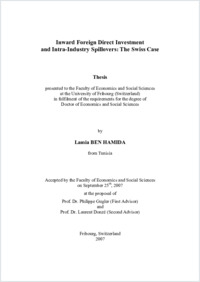Inward foreign direct investment and intra-industry spillovers
- Ben Hamida, Lamia
- Gugler, Philippe (Degree supervisor)
- Donzé, Laurent (Degree supervisor)
-
25.09.2007
205 p
Thèse de doctorat: Université de Fribourg, 2007
English
The attitude towards foreign direct investment (FDI) has changed considerably over the last two decades as many governments around the globe have liberalized their FDI regulations since the early 1980.s and are now actively providing generous investment incentives to attract inward FDI (UNCTAD, 2003). The rationale for these policies often stems from the expectation of FDI spillovers (Caves 1974, Cantwell 1991a, Dunning, 1992), which embodies the fact that foreign .firms own technological advantages. Such as technological know-how, marketing and managerial skills, international experience, and reputation .which can be transmitted to domestic host country firms, raising their productivity level (Blomström and Kokko, 1998). Generally, spillovers are said to take place when the entry and presence of MNC.s a¢ liates leads to productivity or efficiency benefits in the domestic firms and the multinational corporations (MNCs) are not able to internalize the full value of these benefits (Blomström and Kokko, 1998). Such spillovers may occur either in the foreign affiliates own industry or in other industries .among the affiliates suppliers or customers. Intra-industry spillovers may materialize through three main channels. First, there are "demonstration-related spillovers", when the foreign firms after entering the market demonstrate their advanced technologies to domestic firms which may afterwards adapt and imitate them. Second, there are "competition-related spillovers", when the increase in competition that occurs as a result of foreign entry forces domestic firms to introduce new technology and/or work harder. And third, there are "worker mobility-related spillovers", when domestic workers trained by or working in MNCs. affiliates may decide to leave and join an existing or open up a new domestic firm, taking with them some or all of the firms specific knowledge. A large amount of literature has developed over the last two decades on the concept of intra-industry spillovers effects. Too often, existing studies have merely offered a partial description of these effects, since each of them was concerned with analyzing only one means of the effects. Moreover, they have treated the mechanism by which the technology is transferred as a black box. Our study offers a more complete picture of FDI intra-industry spillovers by distinguishing these effects according to their diverse channels. It hypothesizes that the size and the extent of spillovers depend largely upon the mechanisms by which they occur, since the amount and the nature of the technology diffused differ to a great extent according to the way it is transmitted. In addition, domestic technological characteristics such as domestic absorptive capacity and regional proximity are also taken into account in our study along with spillover channels, so as to allow for more detailed analysis of spillover effects. The aim of this thesis is thus to focus in detail on the role of FDI channels as well as domestic absorptive capacity and regional dimension in determining the magnitude and the extent of possible intra-industry spillover benefits from FDI. Unlike existing studies, it calls upon a detailed analysis of these effects according to the mechanisms by which they occur. It argues that the size and the extent of spillover benefits depend largely upon the interaction between the mechanisms by which they occur and the technological levels of domestic firms. In addition, geographical proximity between foreign and domestic firms is an important element in determining the size and the extent of spillover effects; spillovers are more likely to occur between neighbors than other more distant firms. On the basis of these hypotheses, this thesis proposes some components for a research agenda on FDI spillover effects, on both the theoretical and the empirical levels. Relatedly, we develop an evolutionary model of intra-industry spillovers embodying the above hypotheses and we test our theoretical finding against empirical evidence for Switzerland using both qualitative and quantitative analyses .to the best of our knowledge, this study is the first to explore the Swiss case. For the qualitative analysis, we held interviews with managers of foreign and domestic firms of diverse industries from manufacturing and services/construction, operating in Switzerland; while for the quantitative analysis, we made different regression estimations to assess the size and the extent of intra-industry spillovers. Our regression analysis makes use of a thorough measure of domestic absorptive capacity in which the learning and investment efforts of domestic firms come with their existing technological capacities; argument disregarded by most existing empirical studies. Our simulation and empirical results seem to confirm our hypotheses, in which high and mid technology firms benefit a lot from, respectively, competition and demonstration effects, while low technology firms unable to benefit from foreign affiliates via demonstration effects alone, manage to reap this benefit via the recruitment of MNCs. human capital, in that this channel provides some assistance which can help them to imitate successfully the foreign knowledge. Our results also demonstrate that the geographical dimension matters for intra-industry spillovers. Furthermore, the regression results show that only domestic firms which largely invest in the absorptive capacity benefit from spillovers, resulting mostly from the technology transfer.
- Faculty
- Faculté des sciences économiques et sociales et du management
- Department
- Département d'économie politique
- Language
-
- English
- Classification
- Economics
- Notes
-
- Ressource en ligne consultée le 17.10.2007
- License
-
License undefined
- Identifiers
-
- RERO DOC 8219
- URN urn:nbn:ch:rero-002-100737
- RERO R004562176
- Persistent URL
- https://folia.unifr.ch/unifr/documents/300303
Statistics
Document views: 349
File downloads:
- Texte intégral: 294
